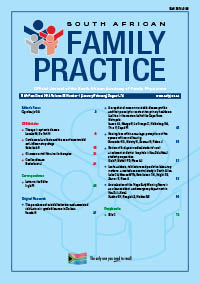An evaluation of the Triage Early Warning Score in an urban accident and emergency department in KwaZulu-Natal
Keywords:
Triage Score, Emergency unit
Abstract
Objective: Triage is an essential first step in the efficient and effective running of any emergency department. A good triage tool saves lives and reduces mortality. The Triage Early Warning Score (TEWS) is a useful tool used to identify patients in emergency departments who are at risk of deterioration and who may require admission. As this triage tool has only been evaluated to a limited extent, this study assessed its effectiveness in identifying patients at risk of early deterioration to enable timely medical intervention. Design and setting: This was a retrospective study of medical records within the accident and emergency department of an urban public hospital. Outcome measures: The calculated TEWS was compared to one of four possible outcomes viz. discharge within 24 hours, admission to the ward, admission to the intensive care unit (ICU), or death in hospital. Pearson’s chi-squared tests and cross-tabulation was used to determine the statistical significance of the association. Results: Of the 265 patient records analysed, 233 (87.9%) had a TEWS of < 7. Of patients with a TEWS of < 7, 53.7% were discharged, compared to 18.7% with a score ≥ 7, who were discharged. The average score of the four patients who died was 9.5, and 8.2 for the three admitted to ICU. Higher TEWS were significantly associated with increased admission to hospital and in-hospital deaths (p-value 0.032). Conclusion: An effective triage scoring system ensures that those requiring emergency care are appropriately categorised. Prompt intervention will either reverse further physiological decline or facilitate timely referral to the appropriate service level, including ICU.
Published
2013-08-01
Section
Original Research
By submitting manuscripts to SAFP, authors of original articles are assigning copyright to the South African Academy of Family Physicians. Copyright of review articles are assigned to the Publisher, Medpharm Publications (Pty) Ltd, unless otherwise specified. Authors may use their own work after publication without written permission, provided they acknowledge the original source. Individuals and academic institutions may freely copy and distribute articles published in SAFP for educational and research purposes without obtaining permission.

